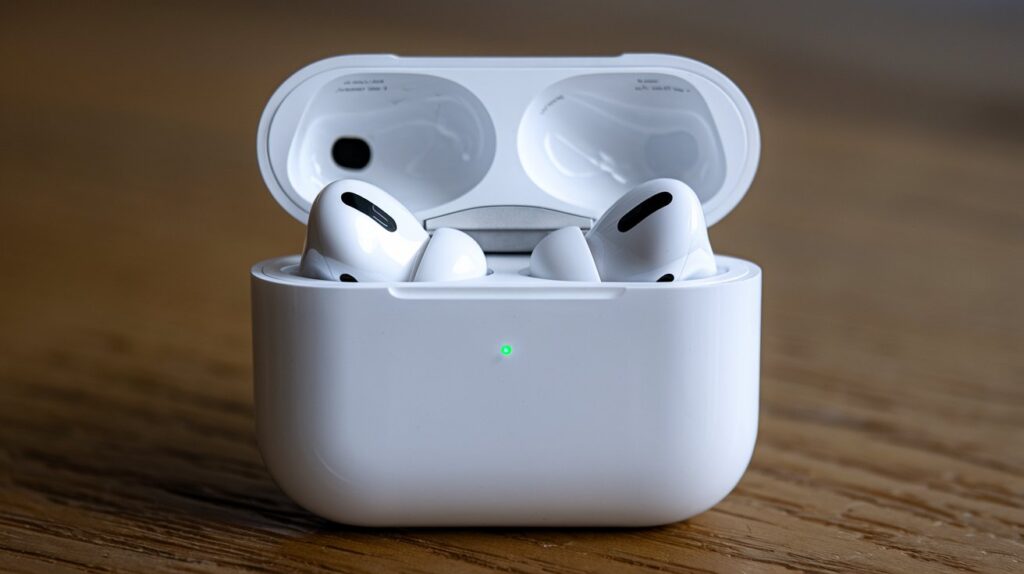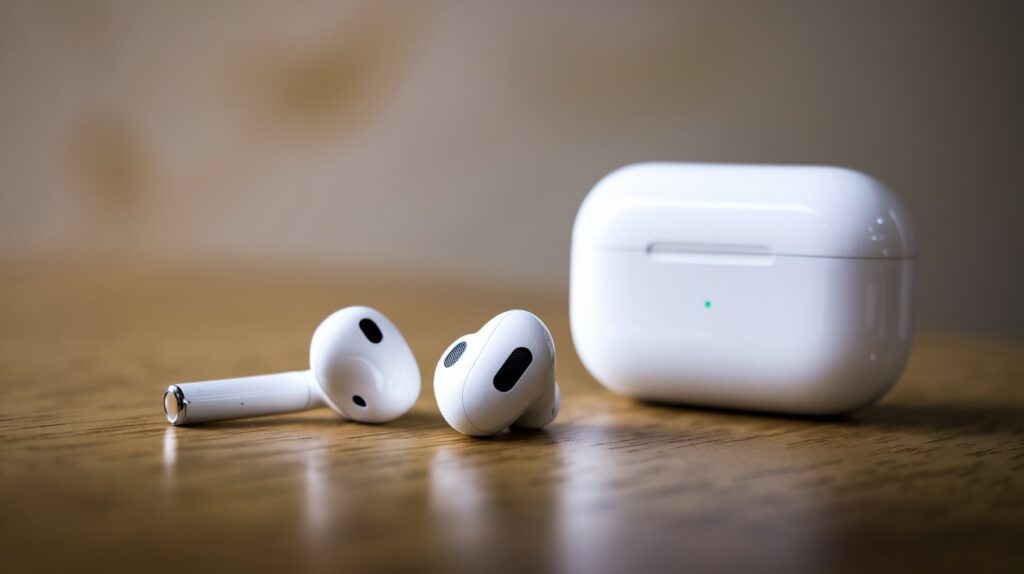A turning point in wireless audio technology occurred when Apple unveiled the AirPods 1st Generation on September 7, 2016, alongside the iPhone 7. Released on December 13, 2016, these wireless earbuds introduced a seamless, cord-free listening experience that reshaped the earbud market. Powered by the innovative W1 chip, the AirPods 1st Gen offered effortless pairing, decent sound quality, and a compact charging case, setting a new standard for convenience and portability. Despite being discontinued in March 2019, their legacy endures, with many users still appreciating their simplicity and reliability. This comprehensive guide dives deep into the AirPods 1st Generation, exploring their features, specifications, performance, and lasting impact, optimized to help you understand why they remain relevant and how they compare to modern alternatives.
toc
AirPods: A Game-Changing Development in Wireless Audio
Apple’s decision to remove the headphone jack from the iPhone 7 sparked controversy, but it also paved the way for the AirPods. Announced at an Apple Special Event, the AirPods were initially met with skepticism, with some comparing their stemmed design to “toothbrush heads” or snipped EarPods. However, their innovative technology quickly won over critics and consumers alike. The AirPods 1st Gen were Apple’s first foray into truly wireless earbuds, building on the legacy of the wired EarPods bundled with iPhones. Apple created a product that felt “magical” to use by integrating the bespoke W1 chip, which addressed common Bluetooth issues such as pairing complexity and battery life.
Key Features of AirPods 1st Generation

The AirPods 1st Gen were packed with features that set them apart from competitors at the time. Here’s a detailed look at what made them special:
- W1 Chip for Seamless Connectivity
The Apple W1 System-on-Chip (SoC) was the heart of the AirPods 1st Gen. It optimized Bluetooth 4.2 connectivity, enabling instant pairing with Apple devices running iOS 10, macOS Sierra, watchOS 3, or later. Opening the charging case near an iPhone triggered a one-tap setup, and iCloud syncing extended this pairing to other Apple devices like iPads and Macs. The W1 chip also ensured low-latency audio and efficient power management, making the AirPods reliable for calls and music. - Automatic On/Off and Ear Detection
The AirPods, which had accelerometers and optical sensors, could tell when you had them in your ears. Audio playback started automatically upon insertion and paused when one or both earbuds were removed, enhancing user convenience and battery efficiency. - Dual Microphones with Beamforming
Each AirPod featured two microphones: one outward-facing at ear level and another at the stem’s base. These used beamforming technology to filter out background noise, ensuring clear voice quality during calls or Siri interactions. - Double-Tap Controls for Siri
Users could double-tap an AirPod to activate Siri, allowing voice commands to adjust volume, skip tracks, make calls, or get directions. While limited compared to later models’ force sensors, this feature was groundbreaking for hands-free control in 2016. - Battery Life and Charging Case
On a single charge, the AirPods could play music for up to five hours or talk for two hours. The compact charging case, powered via a Lightning port, provided an additional 24 hours of listening time. They provide three hours of playback with a 15-minute charge in the case, making them ideal for use while traveling. The battery inside the case was 1.52 Wh (398 mAh), while the battery inside each AirPod was 93 mAh. - Universal Bluetooth Compatibility
While optimized for Apple ecosystems, the AirPods 1st Gen worked as standard Bluetooth 4.0 earbuds with non-Apple devices, including Android smartphones and Windows laptops, though some features like Siri were unavailable.
Technical Specifications
Here’s a detailed breakdown of the AirPods 1st Generation specs:
- A1523 for the AirPod on the left and A1722 for the AirPod on the right
- Each AirPod weighs 0.14 oz (4 g), while the charging case weighs 1.34 oz (38 g).
- AirPods measure 0.65 x 0.71 x 1.59 inches, or 16.5 x 18.0 x 40.5 mm, and cases measure 1.74 x 0.84 x 2.11 inches, or 44.3 x 21.3 x 53.5 mm.
- Chip: Apple W1
- Connectivity: Bluetooth 4.2
- Sensors: include two beamforming microphones, two optical sensors, an accelerometer for detecting speech and motion, and a speech-detecting accelerometer.
- Battery Life: Up to five hours of listening and two hours of talk time; total of twenty-four hours with the case
- Charging: Lightning connector (case)
- Compatibility: iOS 10+, macOS Sierra+, watchOS 3+; Bluetooth 4.0+ for non-Apple devices
- Release Date: December 13, 2016
- Discontinued: March 20, 2019
These specs highlight the AirPods’ focus on portability, ease of use, and integration with Apple’s ecosystem.
Performance and User Experience

Sound Quality
The AirPods 1st Gen delivered decent sound quality for casual listeners, with a balanced profile similar to Apple’s EarPods. They offered clear mids and highs but lacked deep bass due to their open-fit design, which didn’t seal the ear canal. Critical listeners noted average audio reproduction and a limited soundstage, making them less ideal for audiophiles. However, for everyday tasks like podcasts, calls, and pop music, they performed admirably.
Noise Isolation
The open-fit design provided minimal noise isolation, allowing ambient sounds to seep in. This was a drawback in noisy environments like subways but beneficial for situational awareness during activities like running. Unlike later models with Active Noise Cancellation (ANC), the AirPods 1st Gen relied solely on their microphone technology for call clarity.
Comfort and Fit
Weighing just 4 grams each, the AirPods were lightweight and comfortable for extended wear. Their one-size-fits-all design, inspired by EarPods, fit most users but could be unstable for some during intense exercise. The lack of silicone tips or water resistance made them less suitable for workouts compared to modern alternatives.
Battery Life
The AirPods’ battery life was a strong point, with 5 hours of playback and quick charging via the case. Real-world tests confirmed Apple’s claims, and the case’s ability to recharge the earbuds multiple times ensured all-day usability. However, battery degradation over time was a concern, as the small batteries could lose capacity after years of use.
Connectivity
The W1 chip’s seamless pairing was a standout feature, eliminating the clunky Bluetooth setup process. Switching between Apple devices was effortless, and the AirPods maintained stable connections with minimal latency. Non-Apple users faced a standard Bluetooth pairing process but still enjoyed reliable performance.
The Legacy of AirPods 1st Generation

The AirPods 1st Gen were a cultural and technological phenomenon. By 2018, they were Apple’s most popular accessory, outselling Apple Watches and iPads. Their iconic white stemmed design became a status symbol, despite initial mockery, and their ease of use set the benchmark for true wireless earbuds. In 2021, Apple’s wearables category, driven by AirPods, generated an estimated $12.1 billion in revenue, underscoring their commercial success.
Impact on the Market
The AirPods 1st Gen forced competitors like Samsung, Sony, and Bose to innovate, leading to a boom in true wireless earbuds. Features like automatic ear detection and charging cases became industry standards. Apple’s acquisition of Beats in 2014 likely influenced the AirPods’ development, blending Beats’ audio expertise with Apple’s design philosophy.
Comparison with Later Generations
The AirPods 2nd Gen (2019) introduced the H1 chip, “Hey Siri” support, and an optional wireless charging case. The AirPods 3rd Gen (2021) and AirPods 4th Gen (2024) added spatial audio, IPX4 water resistance, and USB-C charging, while the AirPods Pro line brought ANC and silicone tips. Despite these advancements, the 1st Gen’s simplicity and affordability (originally $159) keep them appealing for budget-conscious users.
Current Relevance
As of April 2025, the AirPods 1st Gen are discontinued but available on secondhand markets. They remain functional with modern Apple devices running iOS 18 or later, though their aging batteries and lack of features like ANC make them less competitive. For collectors or users with basic needs, they’re a nostalgic choice, but newer models offer superior performance for most use cases.
Pros and Cons
Pros
- Seamless pairing with Apple devices
- Lightweight and portable design
- Reliable battery life with quick charging
- Clear call quality with beamforming microphones
- Universal Bluetooth compatibility
Cons
- Average sound quality for audiophiles
- Poor noise isolation due to open-fit design
- No water or sweat resistance
- Limited controls (double-tap only)
- Battery degradation over time
Tips for AirPods 1st Gen Users
- Check Firmware: Ensure your AirPods are running the latest firmware (e.g., version 4.2) for optimal performance. Navigate to Bluetooth > AirPods Info in iOS Settings.
- Clean Regularly: Use a soft, dry cloth to clean the earbuds and case to maintain audio quality and charging reliability.
- Extend Battery Life: Store AirPods in their case when not in use to preserve battery health.
- Use with Non-Apple Devices: Press the pairing button on the case’s back to connect to Android or Windows devices.
- Find Lost AirPods: Use Apple’s Find My app to locate misplaced AirPods, a feature enabled via iCloud.
Conclusion
The Apple AirPods 1st Generation, released in 2016, were a trailblazer in the wireless audio space, introducing features that redefined user expectations. Despite limitations like average sound quality and lack of water resistance, their W1 chip, seamless pairing, and compact charging case made them a standout product. While newer AirPods models offer advanced features like ANC and spatial audio, the 1st Gen’s legacy lies in its simplicity and role as a market disruptor. For those still using or considering these earbuds in 2025, they remain a functional, nostalgic option for casual listening within the Apple ecosystem. However, for most users, upgrading to newer models like the AirPods 4 or AirPods Pro 2 will provide a more modern experience. The AirPods 1st Gen will always hold a special place as the earbuds that cut the cord and changed how we listen to the world.
FAQs
Q: How do I pair AirPods 1st Gen with an iPhone or non-Apple device?
A: For iPhone, open the charging case near your unlocked iPhone and tap “Connect” on the pop-up. For non-Apple devices, press and hold the button on the back of the case until the LED flashes white, then select AirPods in the device’s Bluetooth settings.
Q: What is the battery life of AirPods 1st Gen, and how fast do they charge?
A: AirPods 1st Gen offer up to 5 hours of listening or 2 hours of talk time. The charging case provides 24 hours total. A 15-minute charge in the case gives 3 hours of listening time.
Q: Are AirPods 1st Gen compatible with modern iOS devices in 2025?
A: Yes, AirPods 1st Gen work with iOS 18 and later, but some newer features like spatial audio are unavailable, and battery degradation may affect performance.












